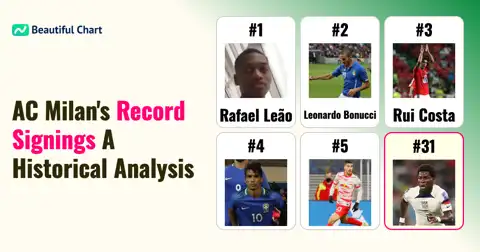This chart highlights the cumulative goals scored by teams in Serie A over the past two decades. Juventus, Inter Milan, and AC Milan consistently rank at the top, showcasing their dominance in Italian football. The data reflects not only each team's offensive power but also their defensive records, indicating trends in team performance and strategy throughout the years.
Serie A: The top professional football league in Italy, consisting of 20 teams. It is one of the most prestigious football leagues in the world, known for its tactical and defensive style of play.
The cumulative goal rankings in Serie A over the past 20 years offer a compelling overview of team performance in one of Europe's top football leagues. Juventus, Inter Milan, and AC Milan, three of Italy's most storied clubs, are prominent at the top of these rankings, illustrating their consistent success. Juventus, in particular, stands out for its balance of high goal-scoring and solid defense, a combination that has led to multiple league titles during this period.
Inter Milan and AC Milan, while also consistently near the top, show some variability in their performance, with periods of dominance and others where they were outpaced by rivals. Inter Milan’s peak periods coincide with their victories in the league and their treble-winning season in 2009-2010 under Jose Mourinho. AC Milan’s cumulative performance reflects their strong runs in both domestic and European competitions, although they faced challenges during certain seasons due to managerial changes and financial issues.
The data also highlights the performance of other notable teams such as AS Roma and SSC Napoli. AS Roma’s cumulative goals show a team that has often been competitive, frequently finishing in the top four, yet never quite reaching the consistent dominance of the top three. Napoli’s rise in the last decade, especially under the management of Maurizio Sarri, showcases a club that has evolved from a mid-table team to a regular challenger for the Scudetto.
Another interesting aspect of the data is the fluctuating performance of teams like Fiorentina, Lazio, and Atalanta. These teams have had periods of both significant success and struggle, reflecting the competitive nature of Serie A, where financial resources, management, and squad depth can lead to substantial shifts in league standings from season to season.
Teams like Udinese and Sampdoria, while not traditionally among the top teams, have had moments of strong performances, particularly Udinese in the early 2010s when they qualified for the UEFA Champions League. The presence of clubs like Parma and Palermo in the earlier years of the data, and their subsequent decline or relegation, speaks to the financial difficulties that some Italian clubs face, which can impact their long-term stability and competitiveness.
Overall, these cumulative rankings not only highlight the consistency of the top teams in Serie A but also underline the volatility and competitive nature of the league, where historical giants are challenged by emerging teams. The data provides insights into the tactical evolutions within Italian football, where defensive solidity and effective counter-attacking have often defined successful teams.
| Rank | Name | Indicator |
|---|---|---|
1 | Inter Milan | 1,353 Goals |
2 | A.S. Roma | 1,312 Goals |
3 | Juventus F.C. | 1,276 Goals |
4 | A.C. Milan | 1,246 Goals |
5 | S.S. Lazio | 1,148 Goals |
6 | S.S.C. Napoli | 1,141 Goals |
7 | ACF Fiorentina | 1,078 Goals |
8 | Atalanta B.C. | 993 Goals |
9 | Udinese Calcio | 942 Goals |
10 | U.C. Sampdoria | 817 Goals |
11 | Cagliari Calcio | 751 Goals |
12 | Genoa C.F.C. | 690 Goals |
13 | Torino F.C. | 680 Goals |
14 | Bologna F.C. 1909 | 660 Goals |
15 | Palermo F.C. | 577 Goals |
16 | Parma Calcio 1913 | 573 Goals |
17 | U.S. Sassuolo Calcio | 553 Goals |
18 | A.C. ChievoVerona | 507 Goals |
19 | Hellas Verona F.C. | 383 Goals |
20 | Empoli F.C. | 381 Goals |





